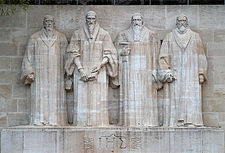
Back Westminster-konfessie Afrikaans Cyffes Ffydd Westminster Welsh Bekenntnis von Westminster German Confesión de Fe de Westminster Spanish Westminsterin tunnustus Finnish Confession de foi de Westminster French Pengakuan Iman Westminster ID Confessione di fede di Westminster Italian ウェストミンスター信仰告白 Japanese 웨스트민스터 신앙고백 Korean

| Part of a series on |
| Reformed Christianity |
|---|
 |
|
|
The Westminster Confession of Faith, or simply the Westminster Confession, is a Reformed confession of faith. Drawn up by the 1646 Westminster Assembly as part of the Westminster Standards to be a confession of the Church of England, it became and remains the "subordinate standard" of doctrine in the Church of Scotland and has been influential within Presbyterian churches worldwide.
In 1643, the English Parliament called upon "learned, godly and judicious Divines" to meet at Westminster Abbey in order to provide advice on issues of worship, doctrine, government and discipline of the Church of England. Their meetings, over a period of five years, produced the confession of faith, as well as a Larger Catechism and a Shorter Catechism. For more than three hundred years, various churches around the world have adopted the confession and the catechisms as their standards of doctrine, subordinate to the Bible. For the Church of Scotland and the various denominations which spring from it directly, though, only the Confession and not the Catechisms is the subordinate standard, the Catechisms not being re-legislated in 1690.
The Westminster Confession was modified and adopted by Congregationalists in England in the form of the Savoy Declaration (1658) and by Particular Baptists in the form of the Second London Baptist Confession (1677/1689). English Presbyterians, Congregationalists, and some others, would together come to be known as Nonconformists, because they did not conform to the Act of Uniformity (1662) establishing the Church of England as the only legally approved church, though they were in many ways united by their common confessions, built on the Westminster Confession.
© MMXXIII Rich X Search. We shall prevail. All rights reserved. Rich X Search